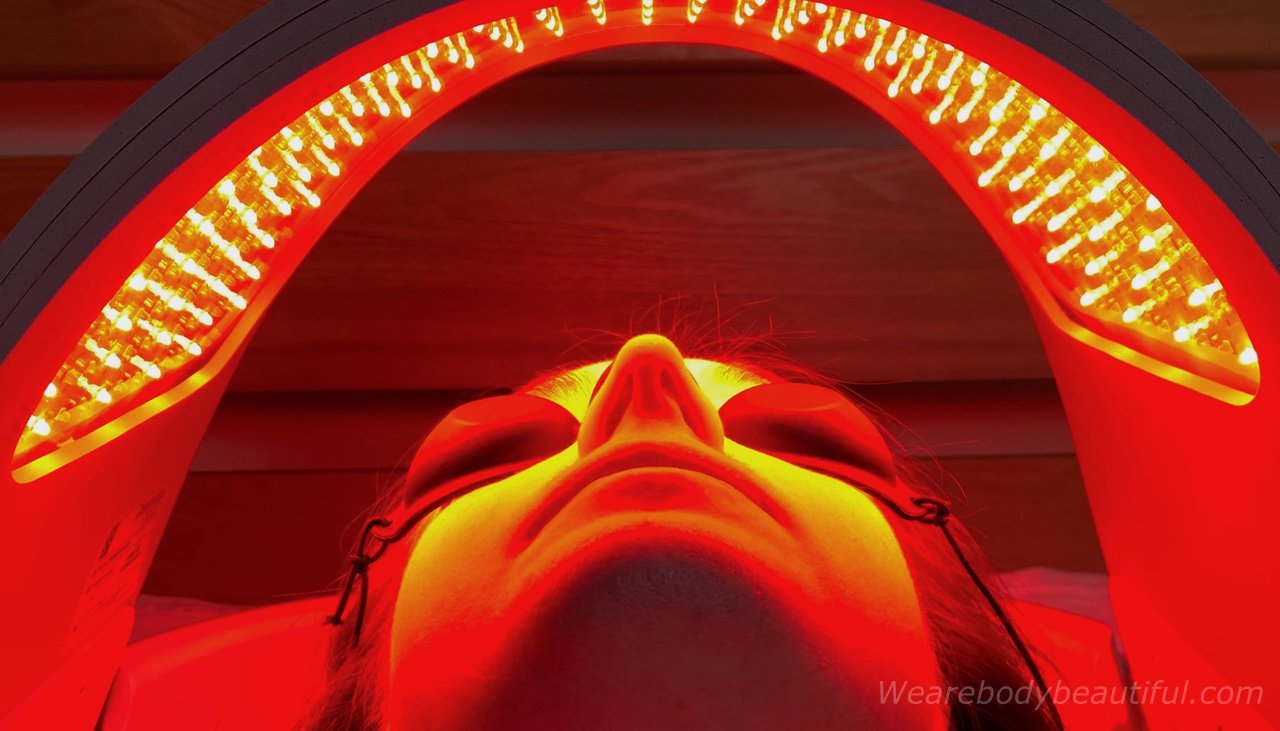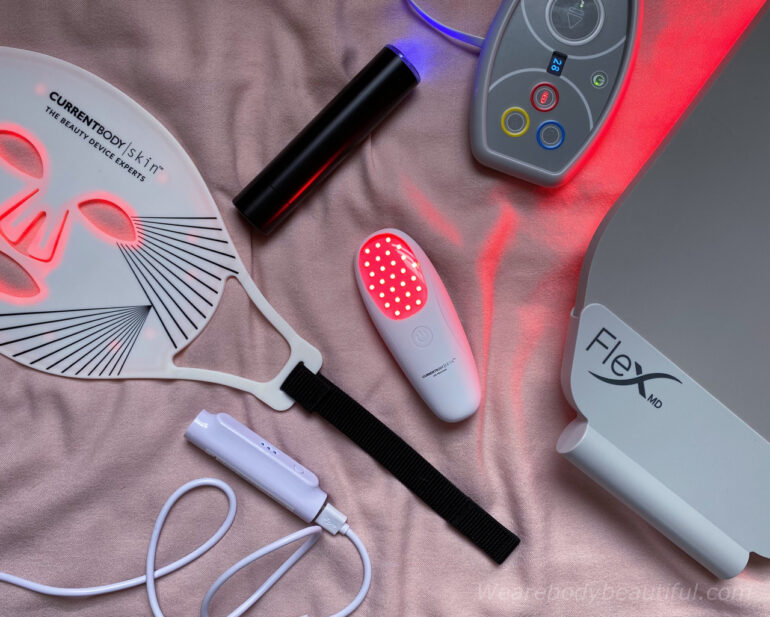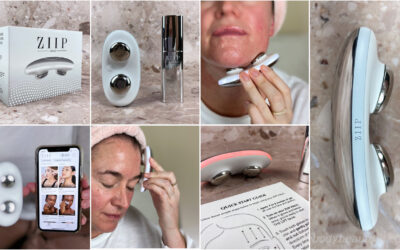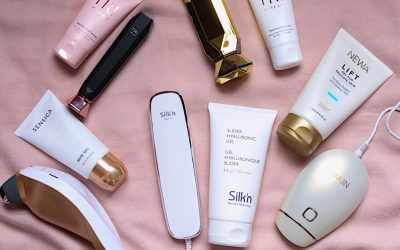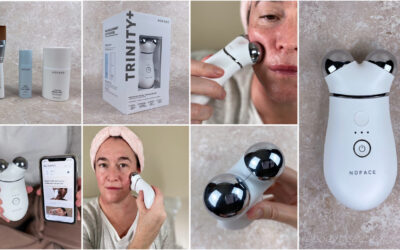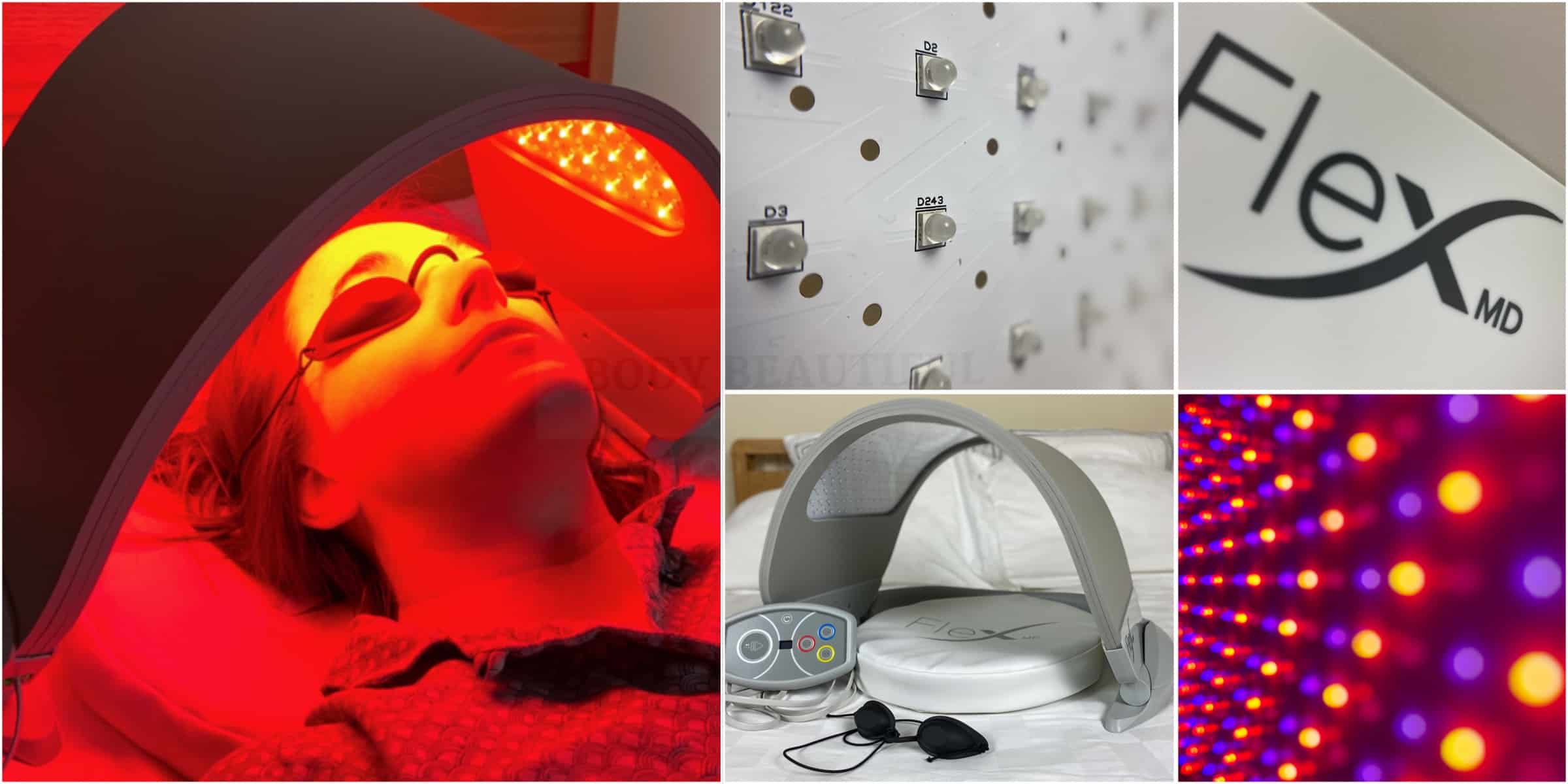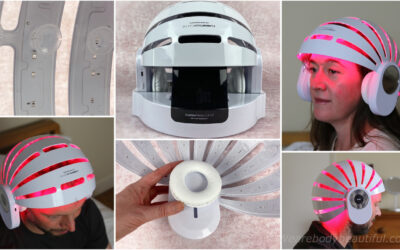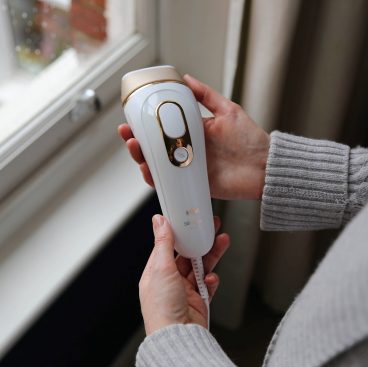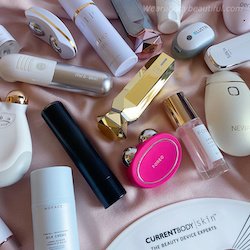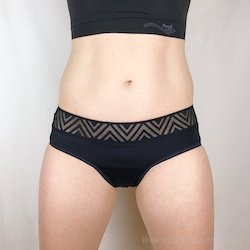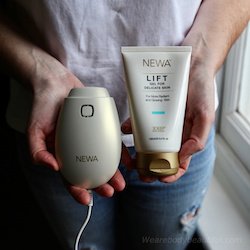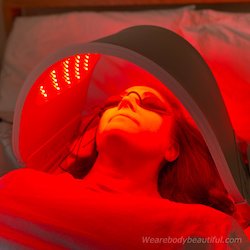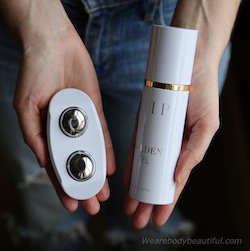What’s your favourite colour? By the end of this article I think you’ll be fairly fond of red. That’s because, from a strong light source, it casts some magical youth-restoring sorcery on your skin.
LEDs are the typical light source, but you can also use lasers and cold lasers. They shine red and near-infrared light onto your skin. There’s no damage, pain or burning sensation. But the light must be of precise wavelengths or it won’t work. The light energy passes through the skin layers and into the deep tissues. It stimulates our cells, boosting growth and healing. Dermatology professionals use it to treat lines and wrinkles, acne, psoriasis, and sun damage. You can buy various home versions too, which work in the same way as professional systems.
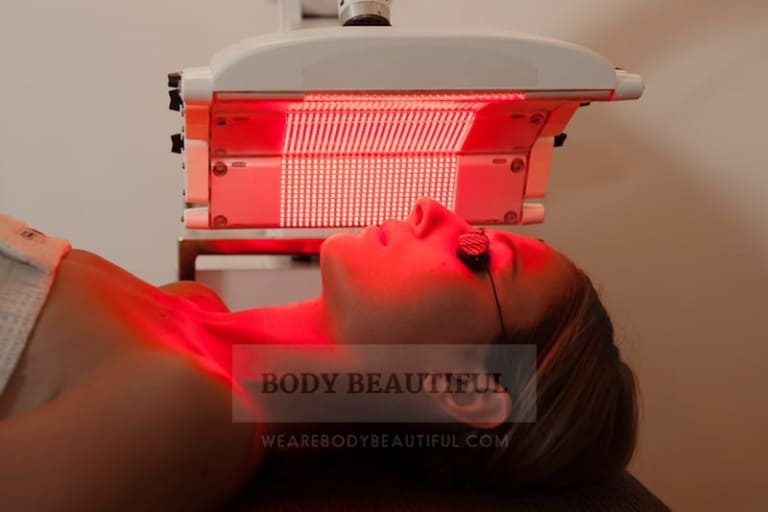
OK, I know. It sounds a bit far-fetched. I was sceptical too. Until I experienced first-hand the glow-giving effects on my 40-something year old skin. Then, I had to know more.
So, it was time to release the Wearebodybeautiful research ferrets. They came back with some grade-A sciencey shit. And now you can learn all here, in red light therapy and facials 101.
Let’s start with a little background.
About light, life & Photobiomodulation
First, we need to understand a bit more about light energy, and how it affects living things by triggering biochemical reactions with photobiomodulation.
What is light?
Sunlight contains every colour of the rainbow, from red to blue. But visible light is only a small part of all light.

We measure light waves in nanometers (nm). The human eye sees light with wavelengths from 380 nm to 700 nm. Light waves shorter than visible violet at 380 nm are ultraviolet (or UV) light. Waves longer than red at 700 nm are infrared (or IR) light. All light is part of the bigger electromagnetic radiation spectrum along with radio waves, microwaves, x-rays and gamma rays. As well as being waves at different lengths and frequencies, light also consists of photon particles.
Now, we know that light affects organisms. Think back to school science lessons. Plants use photon energy from sunlight, along with water and carbon dioxide, during a chemical process called photosynthesis. This creates sugars the plant then uses to grow and live.

Light affects humans too. Certain molecules in our bodies are light-sensitive, and specific wavelengths kick-start biochemical reactions. One example is when light hits special cells in the retinas of our eyes, called photoreceptors. They absorb light and, via a chemical reaction, convert the energy into an electrical nerve signal which our brain processes into vision.
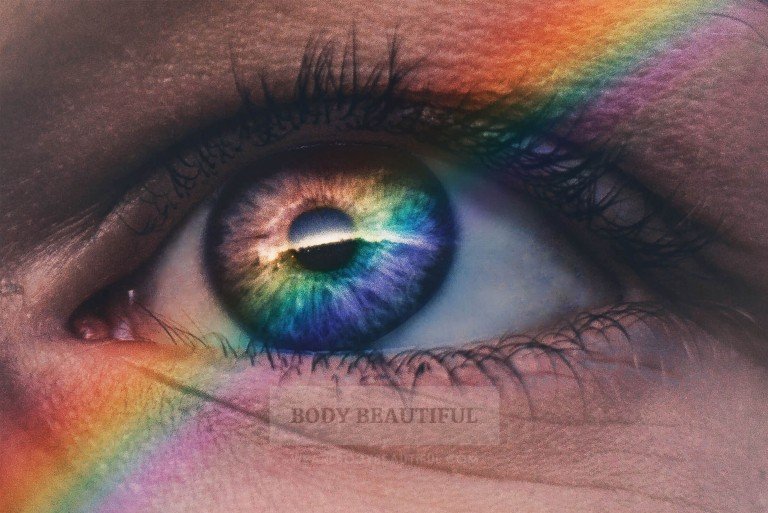
In fact, not getting enough sunlight has a bad effect on us too. For example, you’ve probably heard of Seasonal Affective Syndrome (SAD), and rickets caused by lack of Vitamin D3, both stemming from a lack of sunlight.
This biochemical reaction started by light is called Photobiomodulation.
Photobiomodulation & its uses
The word ‘photo’ means from or produced by light. Light creates changes in our body, which is also known as a photochemical reaction. So, photobiomodulation is the scientific term given to how light can change or modulate a biological system.

INFO: Photobiomodulation therapy using red and near-infrared light has other names too. Such as Low Level Light therapy (LLLT), soft laser, photobiostimulation and red light therapy.
The benefits delivered depend on:
- the specific wavelengths
- and how deep it reaches into your tissues.
Studies show it works to treat pain, inflammation and hard to treat wounds, and even dementia, cancer chemotherapy side effects and brain disorders. It’s widely used to speed-up healing of burns and sunburns by significantly reducing redness, swelling, and peeling of the skin. It also reduces healing time of skin grafts, infected wounds, amputations and other alternative and more aggressive cosmetic procedures such as laser resurfacing.
The therapy also helps to heal, reduce symptoms and reoccurrence of Herpes simplex lesions (cold sores). The red and NIR light helps strengthen immune system cells to help fight the virus in the body. It also speeds-up healing time.
In dermatology, blue light treats acne and red and near-infrared light treats inflammation such as psoriasis and rosacea. And the boost of collagen from red and NIR light also helps soften scarring (both colour and appearance), signs of sun damage and aging, such as sun spots and wrinkles.
Therapeutic red light
It’s a narrow therapeutic range of red light that’s most useful for health, healing and aesthetic purposes.
The human eye sees red light as the wavelengths between 630mn and 700 nm long. It’s used to treat the surface of the skin.
Infrared light is invisible to the human eye, with wavelengths between 700 nm to 1,000,000 nm. The infrared spectrum is divided into near, mid, and far-infrared.
- Near-infrared light or NIR has wavelengths of 700 to 1400 nm. It generates the most heat out of the different red lights. The healing action of near-infrared light can boost tissue repair and increase metabolism. These effects are due to how it stimulates the mitochondria in the cells, but more about that later.
- Mid-infrared light has wavelengths of 1400 to 3000 nm. It can reach the hypodermis, increasing circulation and generating heat to help injured areas of the body.
- Far-infrared light has wavelengths of 3000 nm to 0.1 mm. It can reduce inflammation, pain and fatigue, and increase circulation.
Wavelength, power, and spot size of the light and the thickness, location, and type of tissue affect how deep it reaches into your skin. Skin colour is also a factor6. Therefore, there are no universal figures for wavelength subdivisions, or the depth of skin they can penetrate.
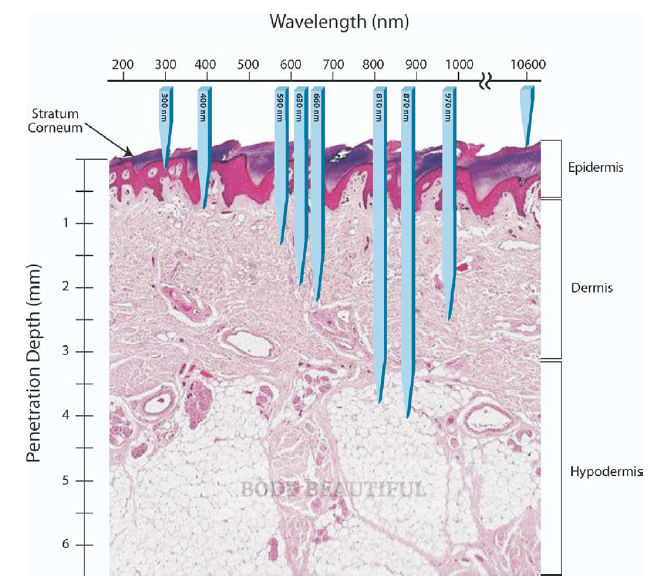
So to recap, red and NIR wavelengths reach to different depths and stimulate our skin cells. Specific light-sensitive molecules inside our cells absorb the light photons and gain energy. This energy excites the cells so they work harder.
Next, we’ll look at what actually happens in our cells.
What does red light do in our cells?
The magic happens in ourcell Mitochondria. The light energizes their cellular respiration process, which results in a surge of vital ATP energy molecule.s To understand exactly what happens, first we’ll look at the cell mitochondria, how they produce ATP and then how red light enhances this process.
What are Mitochondria?
All the cells in your body, except red blood cells, have miniature power generators called mitochondria. They are essential for normal bodily functions. Their primary responsibility is to convert air, water, and food into energy for our cells. Without them, cells couldn’t grow, divide or function. The cells that use the most energy have higher numbers of mitochondria. The liver has up to 4000 mitochondria per cell!
Mitochondria have other roles in cell signalling, balancing calcium, maintaining body heat and killing cells that are no longer useful.
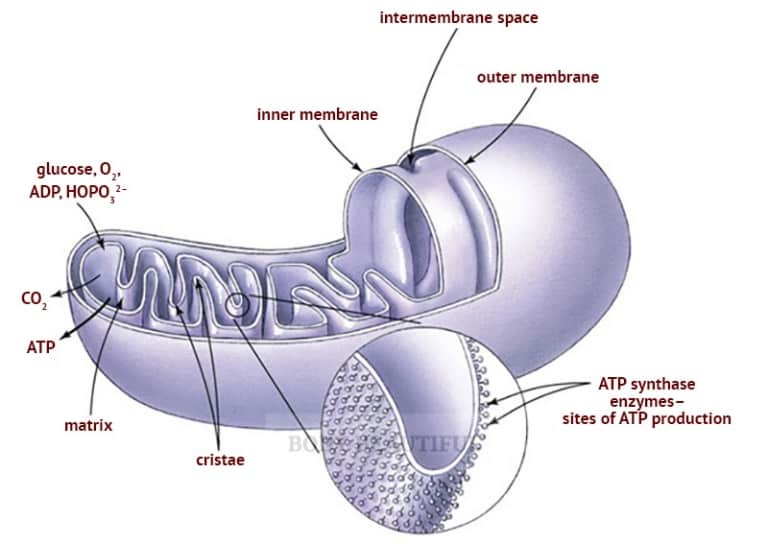
A chemical called adenosine triphosphate or ATP is the energy currency of the mitochondria. And when the mitochondria have more energy, they do more work and the body heals faster.
Mitochondria have an outer and inner membrane with an intermembrane space between the two. Pores in the outer membrane allow proteins, positively charged protons and negatively charged electrons to pass through. The protein-rich inner membrane encases the gel-like matrix, which is where most stages of mitochondrial respiration take place to create ATP.
Mitochondrial respiration to produce ATP
Mitochondria make ATP during cellular respiration. Mitochondrial respiration is either aerobic (with oxygen) or anaerobic (without oxygen). Aerobic respiration is best because it produces more ATP energy. It’s a complex process with four stages.
STAGE 1: Glycolysis. This takes place in cell cytoplasm.
STAGE 2: Pyruvate oxidation. This takes place inside the mitochondria matrix.
STAGE 3: Citric Acid or Krebs cycle. This also takes place inside the mitochondria matrix.
STAGE 4: Oxidative phosphorylation – Electron transport chain & Chemiosmosis, which takes place across the inner mitochondria membrane.
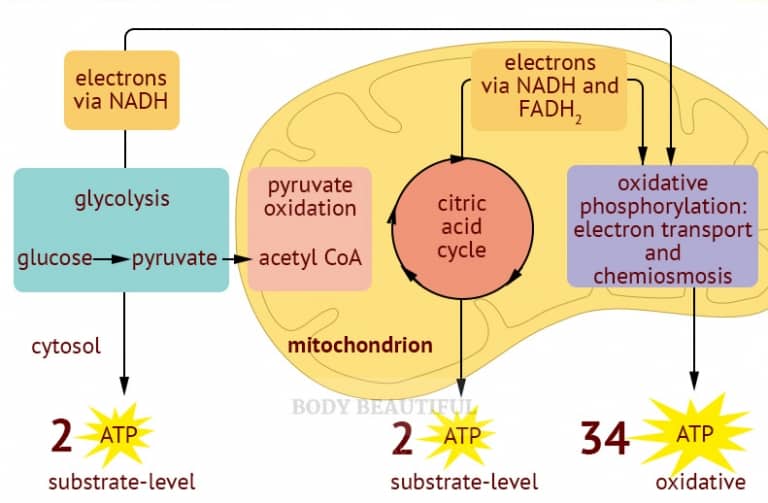
Thankfully, we don’t need to go into the detail of each stage. Suffice to say each stage processes nutrition particles in biochemical reactions to produce either waste (as carbon dioxide and water), or new molecules, electrons and substances used in the next step. Steps 1 & 3 create a little ATP, whereas step 4 creates the most. If you want to boffin-it-up, 🤓 learn more here and here.
So, where does photobiomodulation with red and NIR light come in?
Well, it’s now generally accepted that molecules in a mitochondrial enzyme called Cytochrome c oxidase or COX are the primary light-sensitive chromophores. They absorb either red and NIR wavelengths depending on the depth and tissue type of the mitochondrial location. COX enzyme is also a key player in stage 4 of cellular respiration called Oxidative phosphorylation. To understand how it reacts and why this is good, we must next understand a little more about stage 4 Oxidative phosphorylation.
Stage 4 Oxidative phosphorylation & Cytochrome c oxidase
Oxidative phosphorylation consists of two sub-processes.
- Electron Transport Chain
- Chemiosmosis (via ATP synthase)
Here’s a diagram of the overall process.
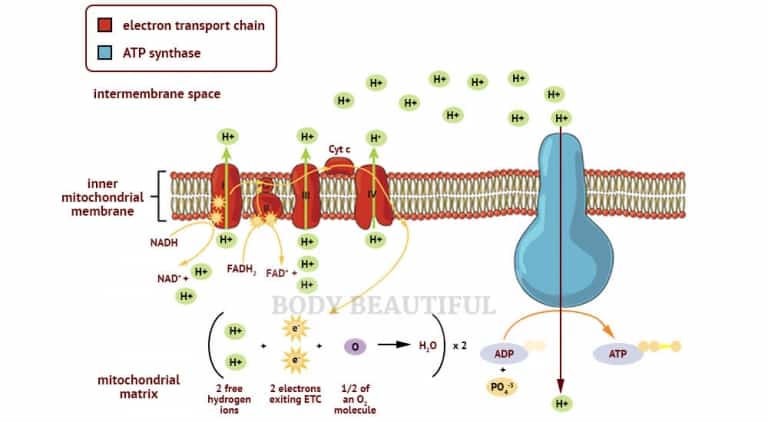
COX is the 4th and final protein enzyme (called a Complex) of the Electron Transport Chain. Each Complex embeds in the inner mitochondrial membrane. Electrons move along the Complexes from molecule to molecule, and as they do, they release energy. The Complex uses this energy to then pump out positive Hydrogen ions (H+ protons) through channels in the inner mitochondria membrane into the intermembrane space.
This build-up of H+ protons creates a proton gradient (or electrical charge like a battery) across the mitochondria inner cell membrane. During the following Chemiosmosis process, the Hydrogen protons flow back into the mitochondria through an enzyme called ATP synthase. ATP synthase harnesses the flow of protons like a turbine to synthesize ATP.
Phew.
Now, the crux of how red and NIR increases ATP production.
How red and NIR increases ATP production
Because red & NIR light stimulates COX, it works harder and more efficiently in Complex IV. This means it moves electrons and pumps protons faster, ready for the final ATP production stage in Chemiosmosis. This increases overall ATP output in the cell.
COX also completes the Electron Transfer Chain more efficiently. It’s an important stage to remove the waste molecules and ensure all respiration stages continue. It does this by handing-off the electrons to Oxygen, which then promptly splits and binds with Hydrogen protons to form water.
And an additional antioxidant effect of Red and NIR photons is important here too.
Red and NIR light donate their proton energy to electrons in the mitochondria. The energised electrons then break the bonds in nitric oxide. This is good because too much nitric oxide blocks oxygen from forming water at the end of the Electron Transport Chain. And this stalls ATP production. So, without excess nitric oxide, the process keeps moving efficiently, creating more ATP.
OK, so how does this increased ATP translate to anti-aging results?
ATP, collagen & elastin
With more ATP our cells work and heal faster. This is super news for our fibroblast calls.
Fibroblast cells in your dermis produce a gel-like support system called the extracellular matrix (ECM). Its made of the proteins collagen and elastin, and proteoglycans, which are highly hydrated sugar molecules. Its these things that make your skin supple and bouncy.
The ECM gives the skin strength, elasticity, and hydration and is essential for healing after an injury.
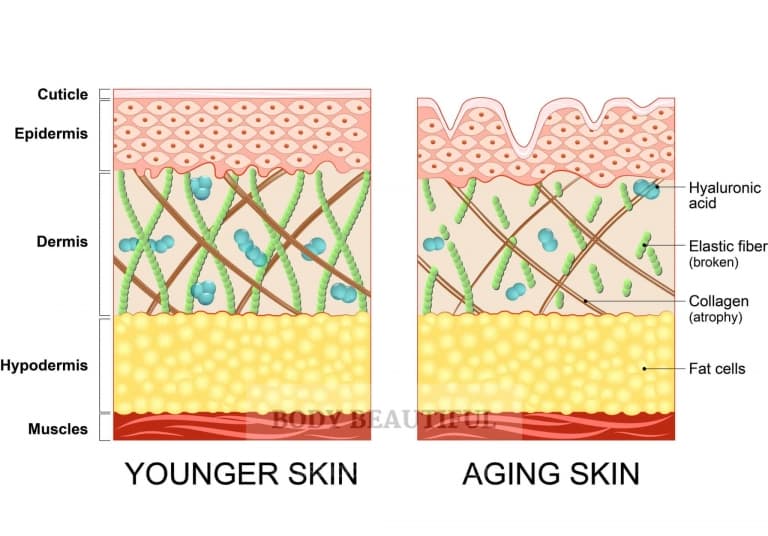
Genetics, lifestyle and environmental factors affect how skin ages. After the age of around 25, the ECM starts to degrade. The production of the essential components slows down, leading to skin that’s drier, weaker, has less elasticity, more wrinkles and imperfections. Boo.
Red light therapy stimulates the mitochondria in your skin cells and specifically your fibroblast cells. They therefore produce more ATP and get an energy boost to build new ECM, regenerate cells and promote oxygen utilization.
So, now you understand what red and NIR light triggers inside our skin, next we’ll look at the results you can expect.
Can I have red light therapy?
Red light therapy is very safe, and tolerated by most people. A sensitivity test patch is not necessary. However, if you have certain medical conditions you must avoid it.
Your clinic or spa will check your medical history. But at-home, you must check your device’s user manual thoroughly. It’s a good idea to download a copy and read it before you buy. Most brands have a PDF version available on their websites. If not, email their support team and request a copy.
Here are the contraindications applying to both professional and at-home red light therapy:

Key checks ✔️
Before you buy a home use device or book a professional sessions, check:
- You’re not pregnant, trying to get pregnant or breastfeeding. (It’s not tested on pregnant or breast-feeding women so the risks are unknown).
- You don’t have an open or bleeding wound

Body areas to avoid ❌
There aren’t any!
Choose a red light facial, or skin rejuvenation on your body, for your decolletage, tummy or knees.

Medical History
Don’t use it if you have a medical history of:
- Lupus erythematosus
- Photosensitive eczema or albinism as it may cause a severe skin reaction
- Any photosensitive disorder (sensitization to light) such as epilepsy
- Light induced headaches
- Any genetic conditions of the eye
- ALWAYS wear goggles with medical strength light if you have eye disease and conditions including Glaucoma, Cataracts, recent laser eye surgery or light induced migraines.

Medications
Don’t use if you’re taking or have recently taken these medications:
- Steroids or cortisone injections
- You are taking any medication that can cause photosensitivity. Medications include certain antibiotics, chemotherapy drugs, and diuretics. If you are unsure about your medication, check with your doctor.
Always check your medication instruction leaflet to see if photosensitivity is a listed side effect.
NOTE: Other substances not listed here can also cause photosensitivity. Common examples are: St John’s wort, coal tar, deodorants, antibacterial soaps, artificial sweeteners, naphthalene (mothballs), petroleum products, brightening agents found in laundry detergent, and cadmium sulphide (a chemical injected into the skin during tattooing).
Preparation for red light therapy
There’s nothing special you must do or avoid before red light therapy, aside from cleansing your skin and removing jewellery. You can safely go out in the sun both before and after your sessions.
Professional sessions are often combined with another treatment such as microdermabrasion. This removes the dry outer skin layers and helps the light penetrate deepest. So, you can also use a microdermabrasion tool or a gentle facial exfoliator before using a home-use device too.
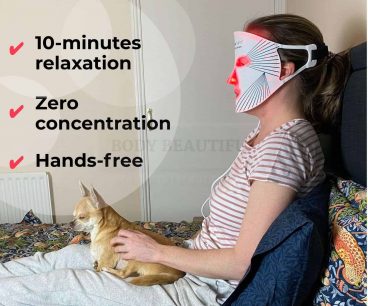
FOR AT-HOME SESSIONS ✔️
- Find a comfy spot, I like to sit on my bed
- Watch TV, listen to music or a podcast, or read a book during your session
- If you need mains power an extension cable is handy
- Have a small, portable mirror handy if you’ve a handheld to treat in sections
- Use your phone to time each section (if needed)
- Tie your hair back so it doesn’t get in the way
What does it feel like?
Red light therapy with powerful LEDs feels very pleasant indeed. It’s bright red and warm, but not hot. There’s no pain or burning sensation.
Most professional machines have a strong, manoeuvrable and pivoting arm with several adjustable panels of lights you can position around your face and body in a canopy. The more panels, the bigger surface area it can treat. You may sit or lie down for the session, depending on which body area you’re treating. The lights are typically 10cm from your skin. It’s most relaxing if you lie down. Goggles are provided because the lights are very bright (but harmless to your eyes).
At-home LED devices vary in design. Most are for the face and neck area.
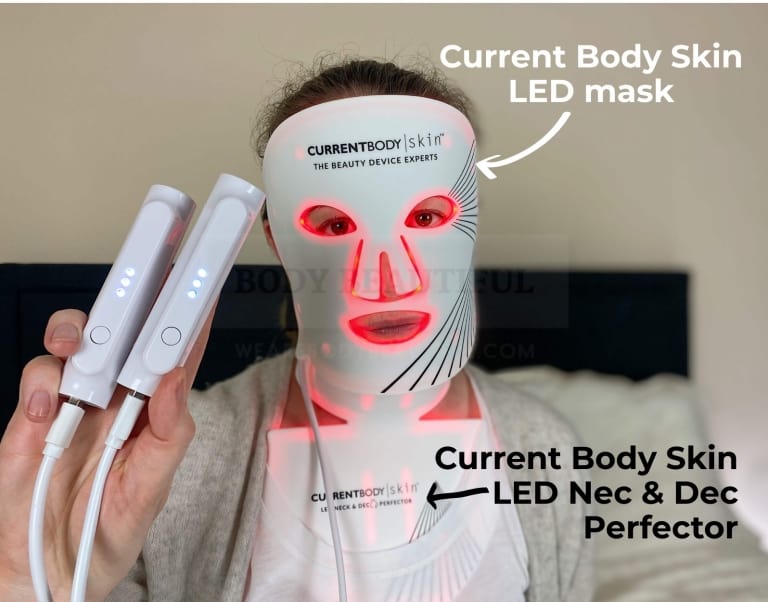
You can choose a handheld wand-shape which you continuously move around your skin. You must treat your face in sections. Therefore, these are best for focused areas such as crow’s feet or around the mouth. They’re pleasant and comfy enough to use for 3 to 10 minutes per area.
Alternatively, you can choose a face mask. Some are a hard moulded shape, normally running on mains-power. Others are soft, flexible, battery-powered silicone masks, like those from CurrentBody Skin . You must wear them for between 10 to 20 minutes per session. They feel a little warm after a while, and don’t get too hot or sweaty.
And there’s one bad-boy medically certified home-use device from Dermalux.
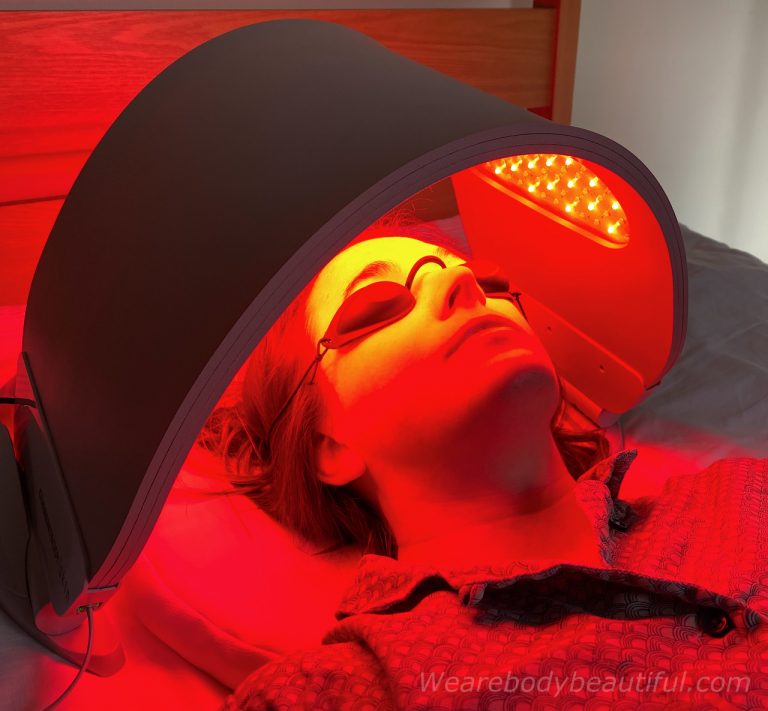
The Flex MD is a mains-powered flexible panel, filled with potent red, NIR and blue LEDs. Not just for your face, you can use it around your whole-body, and comes with goggles too. Use it for 30 minutes in the canopy around your face, and 20 minutes laying directly on other body areas. You can feel a lovely energising warmth in your skin.
Side effects?
Nope.
There are no nasty side effects with red light therapy. Your skin maybe a little red afterwards, but this is simply due to increased circulation in your skin.
Red light therapy schedule & results
Both professional and at-home red light therapy gives best results after a course of sessions.
For professional red light therapy, you’ll need around 6 to 8 sessions in quick succession, one every 24 to 48 hours. You can then opt for periodic top-ups, or repeat the course when you need it. Spas and clinics often combine red and NIR therapy with other skin treatments such as Microdermabrasion, Skin Peels, Micro-Needling, Injectable treatments, and Laser.
The start-up schedules for at-home devices vary from 3 to 5 sessions per week, for 6 to 8 weeks. You’ll notice changes after around 4 weeks, but best results after a few months. The effects build slowly and gradually. Some devices are more efficient and powerful so give faster results. All at-home red light devices are for ongoing use with less regular maintenance sessions, 2 or 3 times per week, or as you feel you need them.
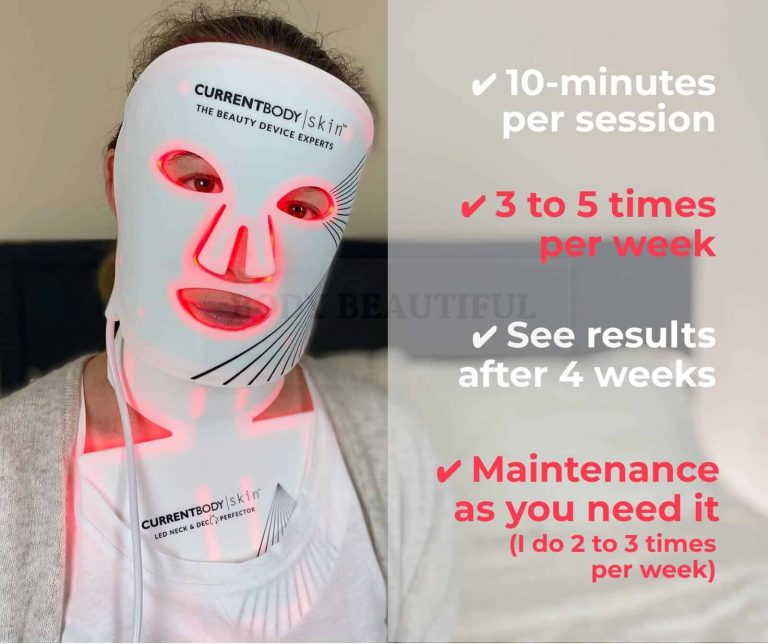
TIP: Try the Dermalux FlexMD medically-cleared at-home device for the fastest and most significant results in just a few weeks. My review explains why it’s superior to cosmetic red light devices and how it gives far better results.
As explained earlier, the lights stimulate your skin cells so they create more ATP energy molecules. This sparks a further series of helpful metabolic events as follows:
- Reduces inflammation
- Increases circulation, cell growth & regeneration
- Faster cell metabolism, lymphatic & antioxidant activity detoxifies cells
- Stimulates fibroblasts to produce more collagen & elastin
Like many other cosmetic technologies, results vary by individual. Your age, skin type, lifestyle, and genetics all play a part. So, for some results are subtle and for others they’re more significant. You’ll usually get faster and more significant results with a professional (or medical) device than a cosmetic-grade home device. However, there are now medically cleared devices available for home-use, albeit with a rather hefty price tag. Typical results are:
- Smoother, firmer & well-hydrated skin
- Brighter skin that glows
- Fades dark spots & pigmentation
- Calms redness & irritation
- Softens acne scarring and other scars
- Minimises fine lines & wrinkles
- Skin looks healthier & younger
Clinical proof for red light facials
Since NASA (18) used red light therapy for experiments on plant growth in the 1990s, doctors have been using it for medical purposes. Numerous clinical research studies show red light therapy is effective.
Research in 36 subjects with sun-damaged skin had positive results. A combined 633 nm and 830 nm light-emitting diode (LED) treatment over five weeks led to significant improvement in wrinkles, softness, smoothness, and firmness of the skin. Electron microscopic analysis showed thicker collagen fibres.26
In a 2014 study of 90 were people treated with 611-650 nm red light (RLT) or 570-850 nm energising light (ELT), and compared to 23 controls. Both treatment groups showed increased intradermal collagen and an improvement in skin feeling and roughness.27
Another study used LED devices to treat 76 subjects with 830 mn, 633 nm, a combination of the two wavelengths or a control light. At the end of four weeks, there was a significant reduction in wrinkles, increase in skin elasticity and an increase in fibroblast activity, collagen and elastic fibres in the treatment groups.28
Professional vs at-home red light therapy
Here’s a comparison table to show the key similarities and differences.
| Professional red light | At-home red light | |
|---|---|---|
| Who’s it for? | ✔️ For men and women ✔️ safe for all skin tones and types. |
✔️ For men and women ✔️ safe for all skin tones and types. |
| What skin types? | Aging, dull or inflammed skin with fine lines, wrinkles, and pigmentation problems. | Aging, dull or inflammed skin with fine lines, wrinkles, and pigmentation problems. |
| Schedule | 🗓 Around 8 sessions in quick succession for best results, one every 24 to 48 hours. | 🗓 3 to 5 sessions per week for 4 to 12 weeks. |
| Maintenance | Less regular maintenance sessions or repeat the course as required. | Ongoing sessions as you need them. |
| Preparation | Clean skin, free from creams or metallic jewellery. It helps to exfoliate before a session. May be combined with other treatments. |
Clean skin, free from creams or metallic jewellery. It helps to exfoliate or use a home microdermabrasion device before a session. |
| Session | The device is perpendicular to your skin, around 10cm away. You may lie or sit depending on the configuration of the device. No gels needed. |
Devices and application vary. Some are flexible or solid light panels positioned close to the face and neck. Others are small handheld devices moved across the skin in sections, solid moulded light masks or (the best) soft flexible battery-powered masks. No gels needed, however with some LED masks you can also apply a hydrating sheet mask. |
| How long is a session? | ⏱ 10 to 30 minutes | ⏱ 10 to 30 minutes (depending on the device). |
| Sensation | No pain or burning sensation. Relaxing down-time. Goggles provided with NIR treatment and as the light is very bright. No downtime. Skin maybe red afterwards due to increased circulation. |
No pain or burning sensation. Handheld or hands-free options No downtime.br> Use before your home microcurrent device.br> Skin maybe red afterwards due to increased circulation. |
| Side effects | None! Very well-tolerated and completely safe procedure. It’s safe to go in the sun before and after a session. |
None! A safe & simple procedure with no side effects. However, overuse can cause dry skin. It’s safe to go in the sun before and after a session. |
| Contraindications | Very safe procedure with just a few reasons you should not use it. | Very safe procedure with just a few reasons you should not use it. |
| Cost | £50 per session or £250 for six sessions | From £99 to £385 |
| Results | Smooth, firm, toned, dewy & healthy skin with a natural glow. Reduces the appearance of fine lines, wrinkles & scars. Results can last many months. |
Smooth, firm, toned, dewy & healthy skin with a natural glow. Reduces the appearance of fine lines, wrinkles & scars. Maintain results with regular weekly sessions, or more/less frequent as you need. |
| Pros & Cons | ✔️ Results are more significant and longer-lasting than home-use devices ✔️ No pain, irritation, or down-time ✔️ More affordable than other professional treatments types ✔️ No negatives! |
✔️ More affordable than professional sessions ✔️ You can maintain results in your home ✔️ Top devices are very low effort ✔️ No negatives! |
At-home red light devices
If you have the dosh and want to splash out, you can try searching locally for a trusted beauty spa. Check the reviews, and ask about the equipment and training before you go ahead.
Or try this instead…
The best at-home red light therapy
Learn all the pros & cons of the best at-home red light therapy devices to give you healthy, hydrated, firm, smooth & bright skin.
Post references
- https://science.nasa.gov/ems/09_visiblelight
- http://www.bbc.co.uk/earth/story/20150731-what-is-a-ray-of-light-made-of
- https://www.aslms.org/for-the-public/treatments-using-lasers-and-energy-based-devices/photobiomodulation
- https://www.aslms.org/for-the-public/general-information/devices—led’s/led-therapy-studies
- https://www.ncbi.nlm.nih.gov/pmc/articles/PMC5843358/
- https://www.ncbi.nlm.nih.gov/pmc/articles/PMC5653719/
- https://www.ncbi.nlm.nih.gov/pmc/articles/PMC6462613/
- https://www.ncbi.nlm.nih.gov/pmc/articles/PMC3617714/
- https://www.ncbi.nlm.nih.gov/pmc/articles/PMC4935255/
- https://www.intechopen.com/books/advances-in-bioengineering/high-brightness-leds-supplied-by-electronics-converters-used-in-tissue-healing-and-cell-rejuvenation
- https://www.ncbi.nlm.nih.gov/pmc/articles/PMC5523874/
- https://www.ncbi.nlm.nih.gov/pmc/articles/PMC3382253/
- https://www.ncbi.nlm.nih.gov/pmc/articles/PMC4684129/
- https://www.nature.com/scitable/topicpage/mitochondria-14053590/
- https://www.khanacademy.org/science/biology/cellular-respiration-and-fermentation/overview-of-cellular-respiration-steps/a/steps-of-cellular-respiration
- https://www.philpoteducation.com/mod/book/view.php?id=835&chapterid=1159#/
- https://www.ncbi.nlm.nih.gov/pmc/articles/PMC1885940/
- https://en.wikipedia.org/wiki/Chromophore
- https://www.khanacademy.org/science/biology/cellular-respiration-and-fermentation/oxidative-phosphorylation/a/oxidative-phosphorylation-etc
- https://iubmb.onlinelibrary.wiley.com/doi/full/10.1002/iub.359
- https://www.frontiersin.org/articles/10.3389/fphys.2014.00305/full
- https://www.sciencedirect.com/science/article/abs/pii/S0300908416301584?via%3Dihub
- https://www.ncbi.nlm.nih.gov/pubmed/28070154
- https://www.researchgate.net/publication/303890737_Proposed_Mechanisms_of_Photobiomodulation_or_Low_Level_Light_Therapy
- https://www.nasa.gov/centers/kennedy/home/plant_growth.html
- https://www.ncbi.nlm.nih.gov/pubmed/16989189/
- https://www.ncbi.nlm.nih.gov/pmc/articles/PMC3926176/
- https://www.sciencedirect.com/science/article/abs/pii/S1011134407000632?via%3Dihub

